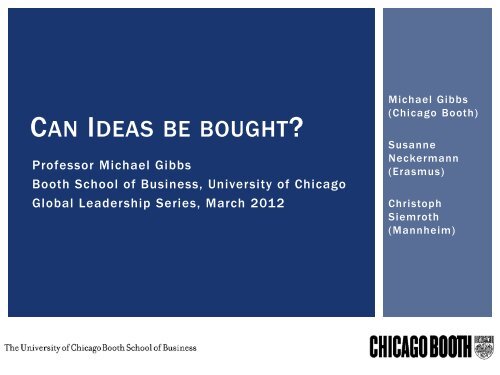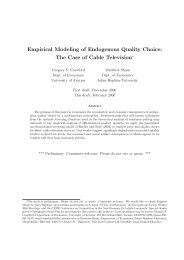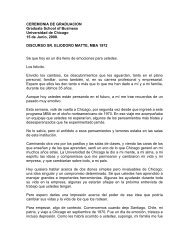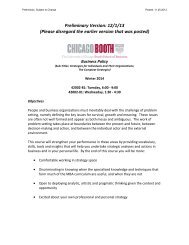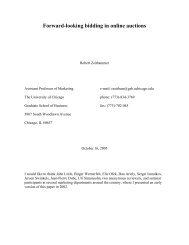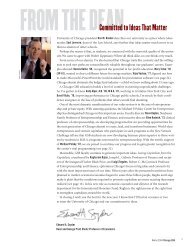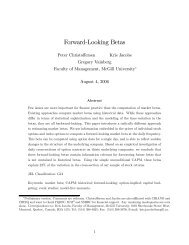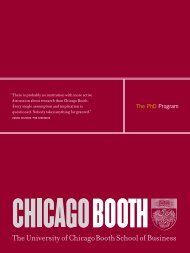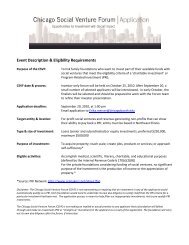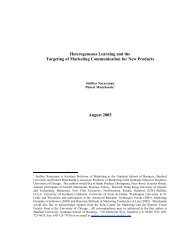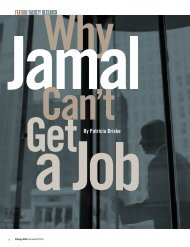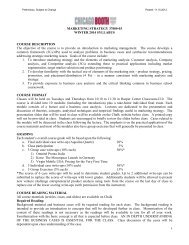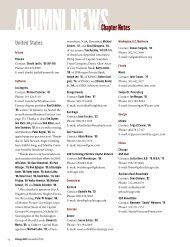View presentation > (PDF) - The University of Chicago Booth School ...
View presentation > (PDF) - The University of Chicago Booth School ...
View presentation > (PDF) - The University of Chicago Booth School ...
- No tags were found...
Create successful ePaper yourself
Turn your PDF publications into a flip-book with our unique Google optimized e-Paper software.
2WHAT DRIVES EMPLOYEE CREATIVITY?• Job design• intrinsic motivation• learning• Collaboration• team: size, composition• brainstorming culture: ideation + debate• Environment• complexity, uncertainty, change• physical proximity• culture
3HOW DO INCENTIVES AFFECT CREATIVITY?• Psychologists argue that incentives “crowd out”intrinsic motivation• <strong>The</strong>re is abundant evidence that incentives can reducecreativity …• … but that does not mean they always do• performance measures may focus on “non-creative” tasks• incentives may cause employees to be more risk averse• both problems can be fixed
4THE COMPANY• Asian technology services co.• outsourcing; SW/HW solutions; R&D• most clients are multinationals• Strategy• from short-term engagements to strategic partner• Desired cultural change• continuous creation <strong>of</strong> client value, innovation• variety <strong>of</strong> policies to focus employees on client / innovation• including new idea portal & reward program
5IDEA PORTAL• Intranet system for collecting employee ideas• anything that adds value for client or internal process• 1000+ per year• abstracts <strong>of</strong> ideas accessible to all employees• Stages for a new idea ideation brief description & classification <strong>of</strong> idea submitted to Portal 1 mgr. evaluates in 3 days, may speak w/ideator to refine/clarify idea vetted by panel <strong>of</strong> managers if approved: client approval if appropriate, then implemented implementation tracked / evaluated
6THE EXPERIMENT• Existing rewards program• points for various contributions• employee can use to buy consumer goods• For Pilot teams: add rewards for new ideas• Control teams w/ no rewards for ideation• random assignment to Control or Pilot
7RESEARCH QUESTIONS• Who ideates?• Experience?+ deeper knowledge <strong>of</strong> client─ higher hanging fruit; complacency• Hierarchical level?+ bigger picture / integrative; strategic view <strong>of</strong> client─ distanced from detailed client work• Collaboration?• Did the Pilot reward program affect ideation?• quantity & quality <strong>of</strong> ideas likely trade<strong>of</strong>f
8DATA• 13 months before & 13 months during Pilot study• Ideas• brief verbal description / category• up to 3 ideators• accepted? Implemented?• total & net dollar value; customer rating• Employee• age, experience, gender• hierarchical level, team• Team• # <strong>of</strong> employees, revenue, Pilot or Control
9Ave. # <strong>of</strong> ideas per periodamong employees who ideateBeforePilotDuringPilotPilot Teams 1.02 1.15Control Teams 1.19 1.28Pre-Pilot Period: July 2009-May 2010 Pilot Period: June 2010-June 2011
10METHODOLOGY• Control for trends, team & employee characteristics “Difference in Differences”1. measure change in ideation before / during Pilot period2. compare change for Pilot v. Control teams• 3 potential effects• # <strong>of</strong> employees who ideate (about 10%)• # <strong>of</strong> ideas per employee, conditional on ideating (about 1.5) eliminate selection bias: include those never ideating estimate 2 effects separately• quality <strong>of</strong> ideas
111. WHO IDEATES?• Age: negatively related to ideation• Tenure: +1 year • odds employee ideates ↑ 1.9% (average = 10%)• if ideates, # ideas ↑ 0.2 (average = 1.5)• tenure effect 8× > age effect … “client human capital” important• Gender• no effect on odds <strong>of</strong> ideation• men who ideate submit 0.2 fewer ideas; 10% higher acceptance• +1 Level: ideate more; higher value & implementation• +1 author: odds accepted 7% higher; higher $ value
122. DID THE PILOT AFFECT IDEATION?• Odds employee ideates ↑ 1.6 points (average = 10%)• # <strong>of</strong> ideas per ideator ↓ 0.3 (average = 1.5)• Net effect approximately zero same # <strong>of</strong> ideas, spread over more employees those ideating before were less likely to during Pilot• Lower level employees: ↑ ideation & $ value <strong>of</strong> ideas• higher level employees decreased both
133. DID THE PILOT AFFECTIDEA QUALITY OR TEAMWORK?• Increased idea acceptance by 19% (average = 64%)• after controlling for $ value good evidence <strong>of</strong> qualityimprovement• No effect on # <strong>of</strong> authors <strong>of</strong> an idea
14CONCLUSIONS• No inherent conflict between incentives & creativity• Improperly designed, incentives will undermineinnovation• Properly designed, incentives reinforce other policiesto drive innovation• ideation is a broad, outcome-based performance measure• reward is for ideas, good or bad; does not cause risk aversion• small rewards for all employees spread innovation to lower ranks• quality improved
15NEXT RESEARCH PROJECT?• Experiment• formal method for cross-team knowledge sharing• “Idea Leader” oversee team ideation• Team composition• size• variety <strong>of</strong> backgrounds• rotation <strong>of</strong> members• co-located or dispersed• Social networks• effects <strong>of</strong> network structure on ideation
• Questions?• New Ideas?


